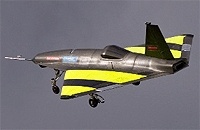First flight for 'flapless' UAV
An unmanned aerial vehicle (UAV) designed to fly without conventional control surfaces has made its maiden flight over Cumbria.
The DEMON UAV made the flight from an airfield at Walney Island on Friday 17 September and was the first of its kind to be authorised by the UK Civil Aviation Authority.
Developed by Cranfield University, BAE Systems and nine other UK universities, DEMON does without conventional mechanical elevators and ailerons that normally control the movement of an aircraft in favour of aerodynamic control using blown jets of air.

According to Cranfield, this ‘flapless’ approach offers several advantages over ‘moving flap’ technology as it requires fewer moving parts, less maintenance and provides the aircraft with a more stealthy profile.
In Cumbria, DEMON successfully demonstrated flapless flight when, for a planned portion of a test flight, the conventional flap control system was turned off and the aircraft flew and manoeuvred using the new technology.
BAE Systems promoted the development of the £6.2m FLAVIIR (Flapless Air Vehicle Integrated Industrial Research) programme that led to the DEMON demonstrator after presenting a ‘Grand Challenge’ to UK universities five years ago.
Register now to continue reading
Thanks for visiting The Engineer. You’ve now reached your monthly limit of news stories. Register for free to unlock unlimited access to all of our news coverage, as well as premium content including opinion, in-depth features and special reports.
Benefits of registering
-
In-depth insights and coverage of key emerging trends
-
Unrestricted access to special reports throughout the year
-
Daily technology news delivered straight to your inbox










Water Sector Talent Exodus Could Cripple The Sector
Maybe if things are essential for the running of a country and we want to pay a fair price we should be running these utilities on a not for profit...